Ten Years on from Fukushima (2/6): The radiological effects of the accident
After the nuclear accident in Fukushima Daiichi, extrapolations revealed that about one-eighth of the amount of radioactivity that escaped at Chernobyl was released into the surrounding area. The maximum estimated radiation dose for the population was 7.5 millisievert. However, various studies revealed that mental problems in the aftermath of the accident had a greater impact on the health of the population than the actual radiation exposure.
After the accident at the Fukushima Daiichi nuclear power plant on 11 March 2011, significant amounts of radioactive substances were released into the environment. They were dispersed by the wind and deposited in the surrounding area, especially as a result of subsequent precipitation. Contaminated water was discharged unchecked into the Pacific. Estimates of the total release led to an INES 7 classification of the accident on the international event scale. This made it an accident of the highest possible level, referred to as a ‘major accident’.
Uncertainties in the amount of radiation released
Experts used estimates and complex calculations to determine the amount of radioactive substances released (the so-called source term). The determination of the source term after the release is equivalent to the inverse of the calculations that ENSI would carry out in the event of a nuclear plant accident in Switzerland: here, the source term and weather forecast data are used to forecast the expected contamination of the environment.
This is why there is a lack of precise information on the release of radioactivity in the event of a nuclear accident
To determine the quantity released, the radioactive substances must be measured during the release or determined by calculation. This is possible if:
- suitable instruments are installed in the plant that can measure large quantities of radioactivity,
- the release is within the measuring range and
- it is known how the radioactive substances entered the environment either via the air or as liquid substances (discharge paths via exhaust air and waste water).
There are various reasons why the quantity of radioactive substances released at Fukushima Daiichi is still not known precisely ten even years after the accident. For example, the release was not measured continuously during the accident because the instruments were not continuously available due to the station blackout (total loss of power) and explosions in the reactor units.
In such a case, any determination of the quantity of radioactive substances actually released is only possible by:
- measuring the subsequent contamination in the environment and
- drawing of conclusions based on the available weather data on wind and precipitation using dispersal calculations.
The timing of the release could be determined using local measurement probes. Such probes are also used in Switzerland to monitor radioactivity in the vicinity of nuclear plants (MADUK measuring probes).
Nevertheless, estimates of the quantity released has associated uncertainties due to the models used in the calculation and the meteorological data available for use in the models. At Fukushima Daiichi, it was also rendered more difficult because contamination over the Pacific could not be measured with stationary measuring probes. Contamination measurements in the ocean and proportional values on land were used to determine this fraction of the source term.
Even ten years after the accident, corrections to the estimated source term are still being made. The corrections are possible because the models for calculating the contamination are constantly being improved or refined, especially in respect of the weather modelling.
The largest release, equal to about one-eighth of the amount of radioactivity released at Chernobyl, took place from 12 to 31 March 2011. Measurements in the vicinity of Fukushima Daiichi showed that two nuclides, iodine-131 and caesium-137, were particularly significant in respect of environmental contamination and public exposure to radiation. Expert teams are of the opinion that, over the entire duration of the accident, caesium-137 with a radioactivity of the order of 1016 becquerel (Bq) and iodine-131 with a radioactivity of 1017 bq was released from three reactor units.
In contrast to Chernobyl, radioactivity was partially contained at Fukushima Daiichi because certain barrier functions were still intact. At Chernobyl, on the other hand, radioactive substances were released unimpeded and continuously for ten days.
Comparison of Releases at Fukushima Daiichi and Chernobyl
To provide a comparison with Chernobyl, the two diagrams below show the release of iodine-131 and caesium-137 during the first ten days of each accident. The total amount of radioactivity released corresponds to the area under the two curves. For the reasons referred to above, Chernobyl’s release values of are even more uncertain than the values of Fukushima Daiichi.
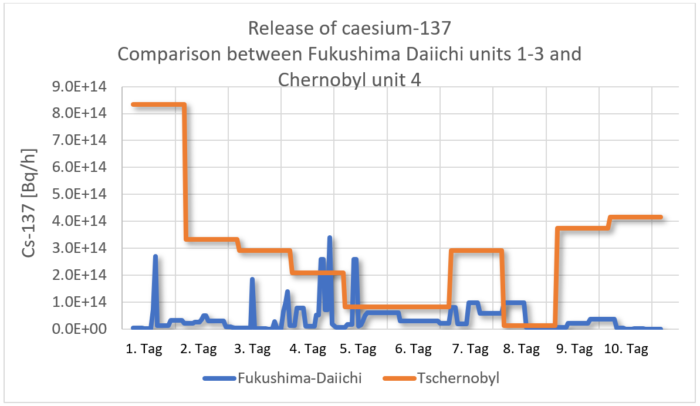
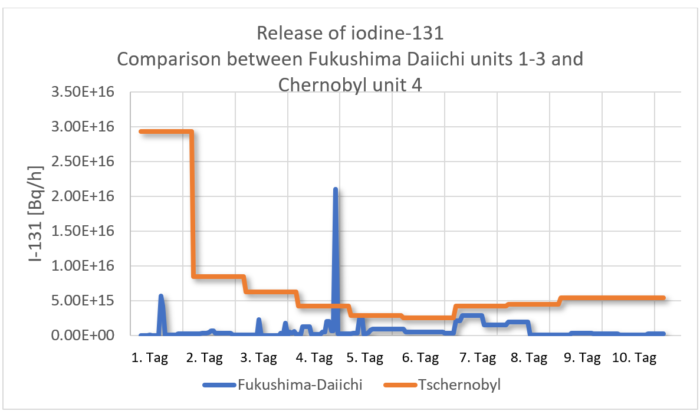
The radiological situation in the surroundings
Rain and snow led to the highest contamination levels north-west of Fukushima Daiichi during the releases in March 2011. Another significant part of the released activity was driven into the atmosphere over the Pacific. According to estimates, up to 50 percent of the caesium-137 released was deposited on the surface of the sea (IAEA, 2015: The Fukushima Daiichi Accident. Technical Volume 4/5. Radiological Consequences). Releases into the atmosphere did not lead to radiologically significant concentrations in the Pacific due to the huge volume of the Pacific Ocean and the resultant dilution of the caesium-137.
During the releases, the radiological situation was primarily tracked using fixed dose rate and air activity measuring stations. The latter indicated increased concentrations of air activity up until the end of April 2011 (IAEA, 2015). However, because there was only a limited number of fixed measuring stations, they did not provide a complete picture of the radiological situation.
From 17 to 19 March 2011, the first measuring flights were made within a radius of 30 kilometres centred on Fukushima Daiichi, in order to measure ground radioactivity. The aeroradiometry performed in this way provided an initial area-wide overview of the radiological situation in this area. Maximum local dose rates of more than 125 microsievert per hour (one millionth of a sievert, μSv/h) were determined. Further measurements were taken from 6 to 29 April and 18 to 26 May 2011 within a radius of one hundred kilometres centred on Fukushima Daiichi and in parts of the prefectures Ibaraki and Toshigi. These measurements have been continued at regular intervals up until today.
After ten years, caesium-137 radiation dominates the area around Fukushima Daiichi due to its approximately 30-year half-life. According to the latest measurements in 2019, local dose rates in the most affected area are still greater than 9.5 μSv/h, about 100 times higher than before the accident.
Measurements from the air
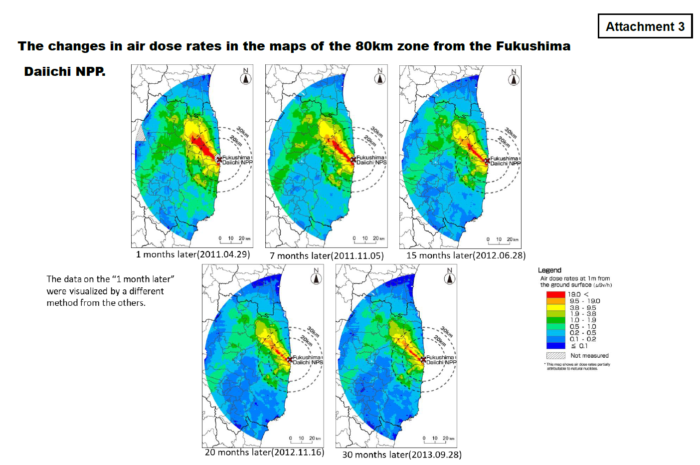
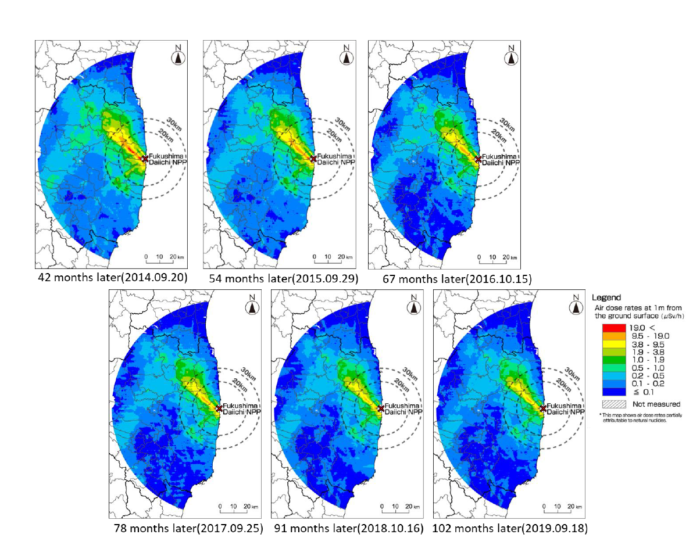
Variation over time of the local dose rate (in µSv/h, at one metre above ground) from the aeroradiometric measurements within a radius of 80 kilometres centred on the Fukushima Daiichi nuclear power plant (source: https://radioactivity.nsr.go.jp/en/contents/14000/13990/24/14th_Airborne_eng.pdf)
Measurements from the ground
In addition to measurements from the air, a comprehensive measurement programme was also carried out on the ground. This included soil samples taken systematically between 6 June and 8 July 2011. The samples were tested for radionuclides. No iodine-131 could be measured in the samples because of its short half-life. For caesium-137, a maximum value of 15.5 MBq/m2 was determined (this corresponds to approximately 520 times the reference value for surface contamination (CS) according to the Radiological Protection Ordinance (RPO: Explanatory notes to Column 12 Annex 3 RPO). The contamination due to strontium isotopes was three to four orders of magnitude lower than that due to caesium-137. Plutonium isotopes could also be detected in some samples, even further away from Fukushima Daiichi. The concentration of plutonium isotopes was in turn three to four orders of magnitude lower than that of strontium isotopes and close to or often even below the detection limit.
In addition to soil samples, air, soil, water and drinking water, flora, fauna and food were investigated for radionuclides both during the accident and indeed continue to be measured right up until today. Iodine-131 was the most prevalent isotope during March and April 2011 thus dominating the radiological situation and resulting in the mandated restrictions on drinking water and food. The restrictions on drinking water were lifted as early as May 2011, because by then activity of the iodine-131 had fallen significantly below 100 Bq/kg due to its short half-life (IAEA, 2015: The Fukushima Daiichi Accident. Technical Volume 4/5. Radiological Consequences). Caesium isotopes and other artificial radionuclides did not pose a radiological problem in drinking water nor in groundwater, river water or seawater.
From May 2011 onwards, caesium isotopes became the dominant factor in the radiological situation – the remaining radionuclides could be neglected due to their shorter half-lives and lower contamination levels.
Caesium concentrations in food decreased over time. Whereas in March 2011, caesium with a radioactivity level of greater than 50 Bq/kg was still found in milk samples, this was reduced to less than 50 Bq/kg for all samples in the following months. With the exception of fish, pork and wild mushrooms, the measured values in food samples had already fallen to below 100 Bq/kg during the course of 2013 (IAEA, 2015: The Fukushima Daiichi Accident. Technical Volume 4/5. Radiological Consequences).
During 2020, none of the food samples with the highest contamination levels from the Fukushima prefecture exhibited measured caesium levels of greater than 100 Bq/kg (https://www.new-fukushima.jp/product). Amongst the contributory factors to this was decontamination work, in which the top layer of soil was removed from agricultural land. It was possible to complete the decontamination work on all but a land area of about 330 km2 (http://josen.env.go.jp/en/). The residents were able to return to the affected areas concerned and the initial restrictions on rice cultivation, for example, were lifted.
Health consequences for the population
As early as the evening of 11 March 2011, people living within a radius of three kilometres of the Fukushima Daiichi plant were evacuated, while from 5amthe next morning evacuation covered a radius of ten kilometres, and on the evening of 12 March a radius of 20 kilometres. In the following months, still further areas were evacuated due to radiation exposure.
Nevertheless, the population of large areas was exposed to ionizing radiation. Radiation entered the body whether through ingested food, breathing or via the skin. In its 2013 Report, the United States Scientific Committee on the effects of Atomic radiation (UNSCEAR) considered different exposure scenarios to determine the accumulated radiation doses for the population.
The dose as a measure of radiation exposure for humans
When a person is exposed to a radiation field, the radiation acts on the body by releasing its energy into the body: It is said that the person has an accumulated dose (accumulated). Doses can be expressed in grays or sieverts. The dose rate is expressed in grays or milligrays and corresponds to the energy absorbed per kilogram of body tissue. On the other hand, the effective dose, which is expressed in sieverts, relates to the sum of the absorbed energy per kilogram of body tissue, multiplied by weighting factors that take into account the biological effect of the different types of radiation as well as the varying radiation sensitivity of individual organs and tissues. Since a dose of one sievert is a very large value, the doses that usually occur are often expressed in millisieverts (one thousandth of a sievert, also written as mSv) or microsieverts (one millionth of a sievert, also written as μSv).
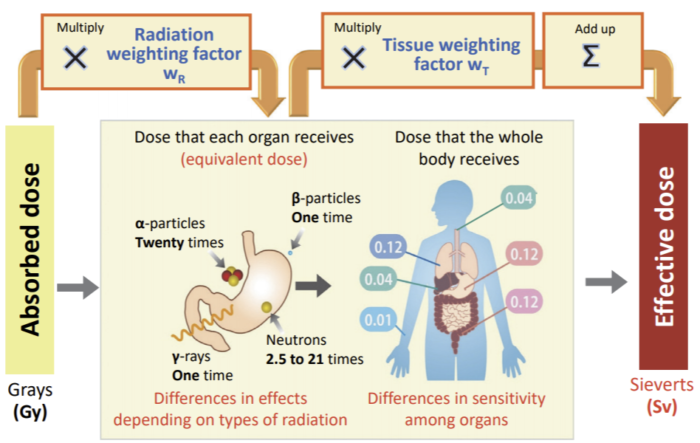
A region with high contamination, where also the highest resulting doses were to be expected, was the Fukushima prefecture. The highest average doses measured there were for infants and had a maximum value of 7.5 mSv. For adults, the corresponding figure was about 4.3 mSv. The table below shows an overview of the doses in different areas and allows comparisons to be made.
To put the magnitude of these values into context: the natural radioactivity in Switzerland from cosmic and terrestrial radiation as well as the radionuclides in the human body results in an average dose of 1.1 mSv per year (per person). The average dose from all sources for a member of the Swiss population is then 5.8 mSv per year.
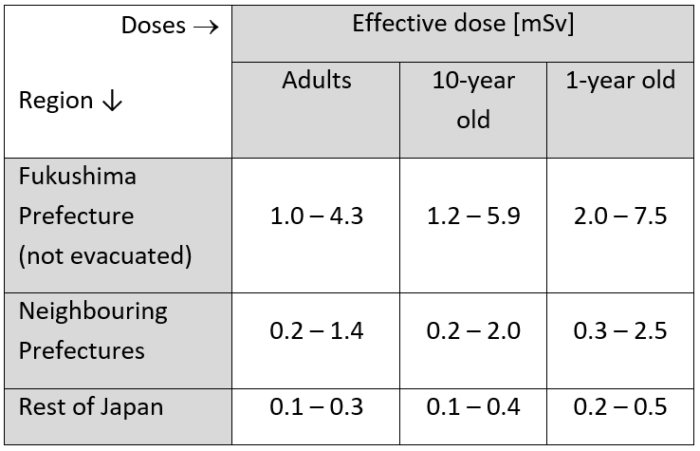
As the general population was only affected by low doses during the Fukushima Daiichi accident, no major health consequences are to be expected, in particular no major effects on body tissues. Based on risk assessments, so few cancer cases were expected that it could not be unambiguously proven that they were due to radiation effects associated with the accident (Health risk assessment from the nuclear accident after the 2011 great East Japan earthquake and tsunami, World Health Organization WHO, 2013).
Due to the increase in thyroid cancer amongst children following the Chernobyl accident, an increased rate was also initially feared after the Fukushima Daiichi accident. Consequently, intensive examinations were carried out on children. A large number of thyroid cysts and solid nodules were found. However, similar, if not slightly higher, rates of cysts and nodules were found in other prefectures that were not affected by significant radionuclide deposits. Therefore, in its report, UNSCEAR assumes that the increased rate in Fukushima prefecture is attributable to intensive testing using more precise methods, rather than to radiation effects(Developments since the 2013 UNSCEAR report on the levels and effect of radiation exposure due to the nuclear accident following the great East-Japan earthquake and tsunami, A 2017 white paper to guide the Scientific Committee’s future program of work, UNSCEAR, 2017 ). Moreover, since the thyroid doses in the area around Fukushima Daiichi were significantly smaller than those around Chernobyl, no increase in thyroid tumours due to radioactivity was observed in Japan.
Furthermore, the UNSCEAR report suggests that mental health problems, for example due to resettlement, have had a greater impact on the health of the affected population than effects due to radiation.
The observation of the affected population continues to confirm the basic statements of the UNSCEAR 2013 report. UNSCEAR is to publish an updated report with the latest findings on the subject in March 2021.
This is the second part of an ENSI series marking the tenth anniversary of the Fukushima disaster of 11 March 2011. The third part relates to EU stress tests and will be published on 18 February 2021.

